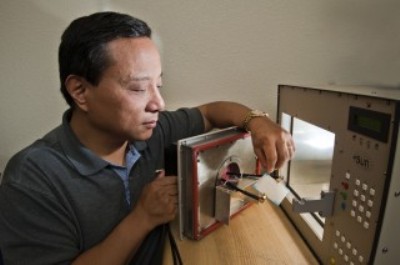Sandia National Laboratories has devised an innovative materials approach to ceramic-based, multilayered three-dimensional microelectronics circuits, like those employed in mobile phones.
 "Sandia National Laboratories researcher Steve Dai has come up with a unique approach to creating materials whose properties won't degenerate when temperatures swing."
"Sandia National Laboratories researcher Steve Dai has come up with a unique approach to creating materials whose properties won't degenerate when temperatures swing."
The method explains how variations that occur due to temperature changes impact the temperature coefficient of resonant frequency, which is an important aspect of materials utilized in microwave and radio frequency purposes. Last fall, Sandia National Laboratories filed a patent for this innovative technique.
The proverbial mobile phone demonstrates how the technology could be utilized. Bandwidth is allotted by the Federal Communications Commission for several applications such as the military, cell phones, aviation, and the likes. All these applications should function under an allotted bandwidth with finite signal-carrying capability. However, when temperatures vary, the materials properties within the phone also vary, and this promotes a change in the resonant frequency at which point a signal is either transmitted or received. Cell phones are made to function in the center of the bandwidth so that they do not drift outside their allotted range of frequency. This precaution however misuses possible bandwidth and forfeits higher rates at which information could travel.
Steve Dai, a researcher at Sandia National Laboratories, worked on low-temperature co-fired ceramic (LTCC), a three-dimensional packaging and interconnection technology that can incorporate resistors, inductors and capacitors. A near-zero temperature coefficient was achieved through Dai’s research by integrating compensating materials within the LTCC.
When temperatures vary, resonant frequencies employed in several LTCC base dielectrics emerge as slanted lines on the graph. The latest technique to an LTCC leaves the line completely flat, which denotes that microwave and radio resonator frequency functions remain consistent even when the temperatures fluctuate.
One advantage of the new approach is that manufacturers may bring down their costs by removing extra electrical and mechanical circuits that are integrated within a device to offset temperature fluctuations.
Dai presented the study results in a paper that appeared in the Journal of Microelectronics and Electronic Packaging.
Source: http://www.sandia.gov/